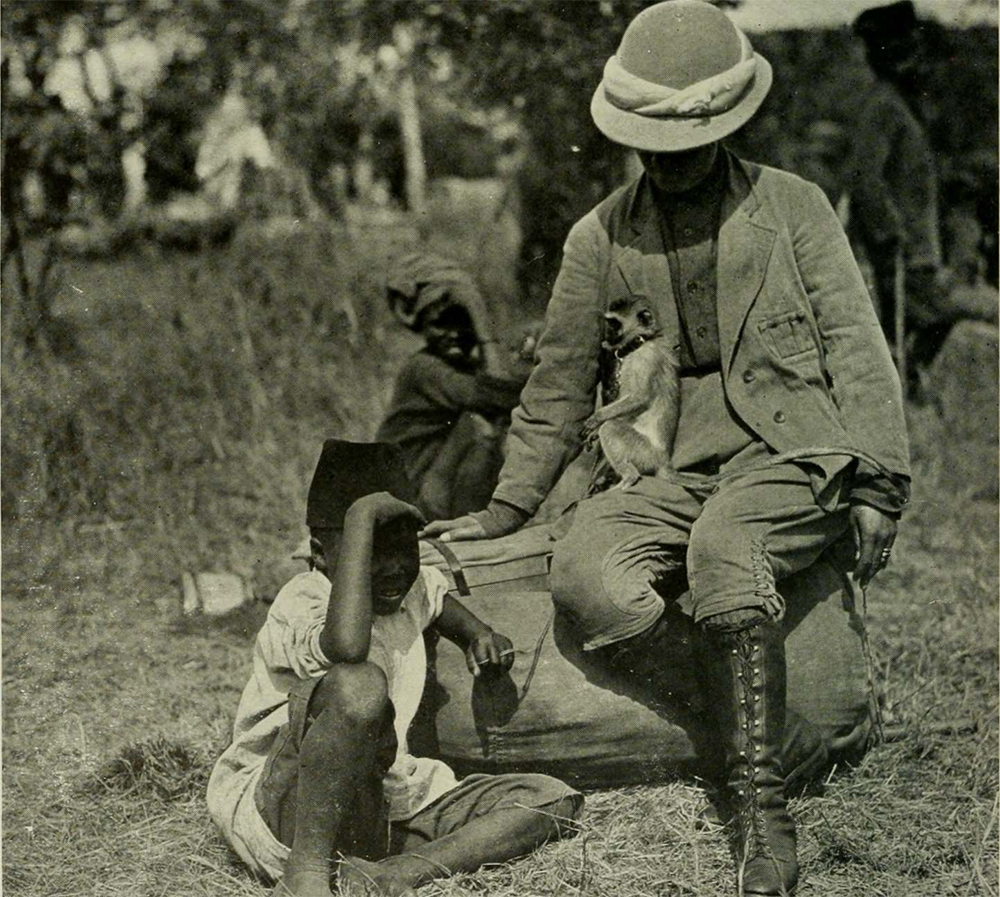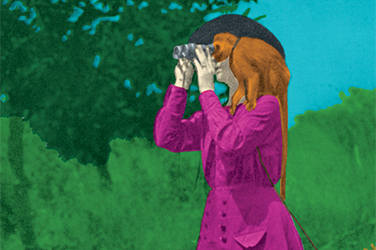
- Free Article: No
- Contents Category: Biography
- Review Article: Yes
- Article Title: Mickie and her monkey
- Article Subtitle: A complicated family history
- Online Only: No
- Custom Highlight Text:
Family histories are always complicated. Delia (‘Mickie’) Akeley and her monkey, JT Jr, are the titular family in this intriguing book, but its story includes the grand global family of colonial museums, and the personal families of Theodore Roosevelt and the author, Iain McCalman.
- Article Hero Image (920px wide):

- Article Hero Image Caption: Delia Akeley on a 1906 expedition to Africa (photograph via the American Museum of Natural History)
- Alt Tag (Article Hero Image): Delia Akeley on a 1906 expedition to Africa (photograph via the American Museum of Natural History)
- Featured Image (400px * 250px):

- Alt Tag (Featured Image): Libby Robin reviews 'Delia Akeley and the Monkey: A human-animal story of captivity, patriarchy and nature' by Iain McCalman
- Book 1 Title: Delia Akeley and the Monkey
- Book 1 Subtitle: A human-animal story of captivity, patriarchy and nature
- Book 1 Biblio: Upswell, $29.99 pb, 232 pp
- Book 1 Readings Link: booktopia.kh4ffx.net/kjba1M
The book opens with a hunting expedition in Africa (1909–12), where Mickie meets JT, and the key elements for the African Hall at the American Museum of Natural History in New York are collected. The expedition unfolds in kaleidoscopic cameos, rich with the sights and smells of ‘darkest’ Africa. Animals are ever-present in this history, macro (elephants and lions) and microscopic, including tsetse flies, ticks, and other fever-making creatures. The tale of the African Hall is enriched by McCalman’s sensitive reading of Mickie’s biography of JT (1928) and her Jungle Portraits (1930).
Carl Akeley, hunter and taxidermist for the Manhattan museum, has a dream: a ‘family’ of elephants charging together at the heart of his future gallery of Africa. The expedition he leads comprises three other hunters: Chicago journalist John T. McCutcheon, businessman Fred Stephenson, and Akeley’s wife, Mickie. The expedition team becomes more complicated when it acquires a feisty infant female vervet monkey. ‘JT Jr’ was so called to annoy the journalist (that is, JT Sr) who regarded the monkey as a liability. Mickie insisted that JT Jr should join them. Some one hundred local porters also accompanied them, as befitted a museum expedition. When JT became attached as firmly to Mickie as the human child she and Akeley never had, a young local boy, Ali, was employed to look after JT so that Mickie could shoot elephants.
The museum’s quest for a large, perfect bull elephant attracted the attention of former President Theodore Roosevelt (‘The Colonel’). Roosevelt’s party included his son, Kermit, forty African porters, and a professional ‘white hunter guide’. The museum needed the sort of sponsorship that Roosevelt’s name attracted, and Roosevelt liked the museum publicity for his African sojourn. Leslie Tarlton, the Australian guide Roosevelt employed, was a forebear of McCalman.
The Akeley Hall of African Mammals features at its centre a free-standing elephant ‘family’ of eight, charging. It still invites conversations with visitors. McCalman documents the appalling carnage and waste in the hunt for the biggest possible bull elephant with perfect tusks. Yet more than one hundred years after they died, the dramatically mounted animal bodies continue to hold pride of place. Now the museum celebrates the artistic presentation of the great taxidermist, rather than the heroism of his hunt. The Hall itself opened as a posthumous memorial to two Great Hunters – Roosevelt and Akeley. It is bright and open, belying its dark secrets. The elephants at its centre were never a family until they were dead. Yet they live on, long after the human families that collected them had unravelled.
The Hall showcases Africa, its animals and their habitats, in a place distant from the heat and dust of the continent. Its walls are lined with twenty-eight vitrines of animals featuring original habitat dioramas of ecological and aesthetic precision. Dioramas are something for which the American Museum of Natural History is now justly famous. Yet they were dreamed up far from Manhattan, by Akeley after a terrible encounter with an injured elephant in Kenya that ripped open his face. Delirious and bedridden, nursed in the jungle by Mickie (and entertained by JT Jr), he poured his fever into planning exhibits. ‘Why stop at resurrecting the bodies and habitats of an elephant family group?’ muses McCalman. ‘Why not create a great temple of nature to exhibit “habitat dioramas” … [for] all the major East African wildlife groups? […] Lying helpless in his cot [Akeley] yearned to deploy his taxidermic talents to recreate the “peace and beauty” of this African wilderness.’ Akeley is a perfectionist and a workaholic, his single-minded vision driving even his unconscious hours.
The ‘front-of-house’ story is the grand African Hall, the envy of every imperial museum. McCalman also unpacks the ‘back-of-house’, exploring the silences in the vitrines, beyond the elephants’ roar.
JT was a central part of the Akeleys’ domestic life in Africa, in their Manhattan apartment, and later at the Rock Park Zoo, Washington (where she died in 1924). She is an absence in the Hall. Mickie, too, is missing from the museum today, appearing only briefly in a website blog about women scientists. The Akeley name was added to the Hall in 1936, but it did not honour Mickie. Mary Jobe Akeley, the museum’s Special Adviser to the development of the African Hall, who had married Akeley in 1924, deliberately excluded his first wife (and her monkey) from the Akeley family history.
McCalman’s forensic sleuthing restores Mickie to her early role as an important observer of monkey behaviour. She became a leader of her own African expeditions, working closely with Batwa and Bambuti (Pygmy) peoples in Congo. Her intuitive understandings of animals and people revealed much that the heroic masculine hunters never grasped. Blinded by anxiety about their American manhood, the white male hunters missed the opportunity to observe JT on her own terms, distracted as they were by ‘the conjoint activities of exhibition, conservation and eugenics’.
This book is about Africa but also about the stifling limits of New York that drove Akeley, his two wives, and JT to different sorts of madness. Fevers are often associated with African jungles, but the expectations of the urban jungle of Manhattan added another level of craziness. As museums serve postcolonial audiences today, their silences and historical aspirations become even more important. Delia Akeley and the Monkey is a highly original dive into the intergenerational museum family. McCalman has rethreaded interspecies and colonial stories together, even finding a niche for the bon-bon bowls of his African childhood. Those bowls, made from an elephant’s toenails, were all that was preserved from an ‘imperfect’ bull discarded by the Colonel. He presented these tiny personal treasures to his white hunter guide. More than a century later, McCalman has finally restored the animals left behind to the story of the African Hall.


Comments powered by CComment